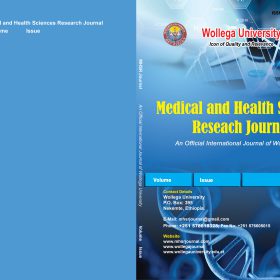Sero-prevalence and Associated Risk Factors of Hepatitis B, Hepatitis C and Human Immuno Deficiency Viruses among Blood Donors at Nekemte Blood Bank, West Ethiopia
DOI:
https://doi.org/10.20372/mhsr.v1i1.76Keywords:
Hepatitis B Virus, Hepatitis C Virus, HIV, Risk factors, Blood donors, NekemteAbstract
Blood serves as a vehicle for transmission of Blood–Borne pathogens and hemo-parasites. Transfusion transmissible infections agents such as Hepatitis B, Hepatitis C and HIV Viruses are among the greatest threats to blood safety for the recipients and on the economy of the country. Therefore, the study of sero-prevalence of Hepatitis B, Hepatitis C and HIV Viruses are important to assess the magnitude and risk of Hepatitis disease and HIV transmission and for its prevention and control strategies. The objective of this study was to determine the sero-prevalence and associated risk factors of Hepatitis B, Hepatitis C and HIV viruses’ infection among blood donors at Nekemte blood bank. An institutional based cross sectional study was conducted on conveniently selected 97 blood donors from April to May, 2016. The socio-demographic characteristics of blood donors were collected using pre-structured questionnaire. Blood collected from donors were tested as per the protocol for Hepatitis B virus surface antigen, Hepatitis C and HIV viruses’ antibody. Data was analyzed to assess the association between independent variables and Hepatitis B, Hepatitis C and HIV viruses’ sero-status. A total of 97 blood donors were examined for Hepatitis B, Hepatitis C and HIV viruses’ sero-status. Among 97 study participants, 6 blood donors were found to be sero- positive for HBsAg, giving the Sero-positivity of 6.2% for HBV. From the 6 sero-positive donors for HBV, 5 were males and 1 was female giving the prevalence of 5.95% and 7.7% respectively. Majority of them 2(33.3%) were found in age category of 28-32. Urban resident blood donors were more infected (6.8%) than rural residents (4.3%). Proportion of positive HBsAg was high among female than males and in individuals with multiple sexual partners and those individual who have exposure history of liver disease. The prevalence of HBV is considerably higher than HCV and HIV among blood donors at Nekemte Blood Bank. Thus, health education about the transmission, prevention and awareness of viral infections should be strengthened by all concerned bodies to tackle this problem.
Downloads
References
Abdel Salam, M.H.E, Ahmed, A.A.E., Nasir, M.H.E (2008). Sero-prevalence of immunodeficiency virus, hepatitis B and C and syphilis among blood donors at ElObeid Teaching Hospital, West Sudan. Sudan Journal of Medical Science 3(4): 333-338.
Alter, H.J., Seff, L.B. (2000). Recovery, persistence and sequelae in hepatitis C virus infection: a perspective on long term outcome. Seminars in Liver Disease 20: 17-35.
Ayele Adato Kabato and Gebru Mulugeta Weldearegay (2016). Prevalence and associated risk factors of Hepatitis B and Hepatitis C virus among volunteer blood donors in Arba Minch Blood Bank SNNPR, Ethiopia. Journal of Medical Laboratory and Diagnosis 7(4): 20-27.
Dhawan, H.K., Marwaha, N., Sherma, R.R., Chawla, Y., Thakral, B., Shawja, K., Sharma, S.K., Thakur, M.K., Jain,
A (2008). Anti-HBc screening in Indian blood donors: still an unresolved issue. Worlds. Gastro Enterology 14(34): 5327-5330.
Fithamlak, S.B., Fanuel, B.B., Temesgen Anjulo, A. and Fiseha W.Wada (2016). Transfusion Transmissible Infections among Voluntary Blood Donors at Wolaita Sodo University Teaching Referral Hospital, South Ethiopia. Canadian Journal of Infectious Diseases and Medical Microbiology Volume 2016, Article ID 8254343, 6 pages
Gasiorowicz, M., Hurie, M., Russel, A., Hoxie, N., Vergeront,
J. (2006). Epidemiologic trends in infection, mortality and transplant related to hepatitis C in Wisconsin. Wisconsin Medical Journal 105(1): 34-39.
Glynn, S.A., Kleinman, S.H., Schreiber, G.B., Michael, P.B.,
David, J.W., James, W.S., Catharie, C.N., Alan, E.W., (2000). Trends in incidence and prevalence of Major Transfusion Transmitted Viral infections in US blood Donors, 1991 to 1996. JAMA 284(2): 229-235
Houghton, M., Weiner, A., Han, J., kuo, D.G., Chan, Q.L. (1991). Molecular biology of the HCV: Implication to development and control of vital disease. Hematology 14(2): 381-388.
Lathamani, K., Geetha, B., Shivananda, N., Subbannayya, K. (2013). Prevalence of HIV, HCV, HBV and Syphilis in Blood donors among the Dakshina Kannada District, India. International Journal of Current Microbiology and Applied Sciences 2(10): 249-252.
Lion, H.G (1995). Allogeneic transfusion risk in the surgical patients. AMJ Surgery 1702: 21-26.
Melese Abate and Tesfaye Wolde (2016). Seroprevalence of Human Immunodeficiency Virus, Hepatitis B Virus, Hepatitis C Virus, and Syphilis among Blood Donors at Jigjiga Blood Bank, Eastern Ethiopia. Ethiopian Journal of Health Sciences 26(2): 153-160.
Miriam J. Alter., Deanna Kruszon-Moran., Omana V. Nainan., Geraldine M. McQuillan., Fengxiang Gao., Linda A. Moyer., Richard A. Kaslow., and Harold S. Margolis (1999). The Prevalence of Hepatitis C Virus Infection in the United States, 1988 through 1994. 345: 41-52.
OkUda, M, Hino, K., Korenaga, M., Yamaguchi, Y., Katoh, Y, Okita, K. (1999). Differences in hypervariable region 1 quasispecies of hepatitis C virus in human serum, peripheral blood mononuclear cells, and liver. Hematology 29: 217-222.
Tajeldin M. Abdallah and Abdel Aziem A. Ali (2012). Sero- prevalence of transfusion-transmissible infectious diseases among blood donors in Kassala, eastern Sudan. Journal of Medicine and Medical Sciences 3(4): 260-262.
UNAIDS (2014). the global HIV/AIDS epidemic. August 2014.
Williams Walana., Samuel Ahiaba., Patrick Hokey., Ezekiel Kofi Vicar., Samuel Ekuban Kwabena Acquah., Edmund Muonir Der and Juventus Benogle Ziem (2014). Sero- prevalence of HIV, HBV and HCV among Blood Donors in the Kintampo Municipal Hospital, Ghana. British Microbiology Research Journal 4(12): 1491-1499.
World Health Organization (1997). Hepatitis C; global prevalence-update. Weekly Epidemiological Record 72: 341-348.
Downloads
Published
How to Cite
Issue
Section
License
Copyright (c) 2023 Medical and Health Sciences Research Journal

This work is licensed under a Creative Commons Attribution-NonCommercial 4.0 International License.
Medical and Health Sciences Research Journal,
MHSR © 2023 Copyright; All rights reserved





